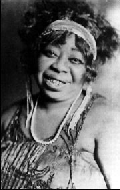- A Patriarchal Genre ? Women
Part Two
Women In Blues - Part two
 Ma
Rainey was not a singer blessed with conventional good looks-she was chubby-faced
and stocky nonetheless she dressed the part of a blues queen. Her stage
wardrobe consisted of lavishly sequined gowns, glittery headbands, and
plenty of jewelry, including a necklace of gold coins. Offstage, Rainey
was known to be sexually promiscuous. Few historians can point to any genuine
blues singers before Ma Rainey. She ended up recording 100 songs between
1923 and 1928. During that time she was accompilied by many noted jazz
musicians such as, Louis Armstrong, Tommy Ladnier, Fletcher Henderson,
and Coleman Hawkins. She continued working until 1935 when she retired
to Columbus, Georgia. Rainey invested her money wisely and had built and
operated two theaters, while owning her own home in Columbus. After a successful
singing career, she sadly died in 1939, of a heart attack.
Ma
Rainey was not a singer blessed with conventional good looks-she was chubby-faced
and stocky nonetheless she dressed the part of a blues queen. Her stage
wardrobe consisted of lavishly sequined gowns, glittery headbands, and
plenty of jewelry, including a necklace of gold coins. Offstage, Rainey
was known to be sexually promiscuous. Few historians can point to any genuine
blues singers before Ma Rainey. She ended up recording 100 songs between
1923 and 1928. During that time she was accompilied by many noted jazz
musicians such as, Louis Armstrong, Tommy Ladnier, Fletcher Henderson,
and Coleman Hawkins. She continued working until 1935 when she retired
to Columbus, Georgia. Rainey invested her money wisely and had built and
operated two theaters, while owning her own home in Columbus. After a successful
singing career, she sadly died in 1939, of a heart attack.
Another great blues singer of the period was Bessie Smith who was born
poor in Chattanooga, Tennessee, in1894. Before she reachedwomanhood, both
her mother and father had died. Smith was the greatest and most influential
classic  blues
singer of the 1920s. Her full-bodied blues delivery coupled with a remarkable
self-assuredness that worked its way inand around most every note she sang,
plus her sharp sense of phrasing, enabled her toinfluence virtually every
female blues singer who followed. During her heyday, she soldhundreds of
thousands of records and earned upwards of $2000 per week, which was aqueenly
sum in the 1920s. She routinely played to packed houses in the South, North
and Midwest. By the time the decade had ended, Smith had become the mostrespected
black singer in America and recorded a catalog of blues that still stands
as the yardstick by which all other female blues singers are measured.
blues
singer of the 1920s. Her full-bodied blues delivery coupled with a remarkable
self-assuredness that worked its way inand around most every note she sang,
plus her sharp sense of phrasing, enabled her toinfluence virtually every
female blues singer who followed. During her heyday, she soldhundreds of
thousands of records and earned upwards of $2000 per week, which was aqueenly
sum in the 1920s. She routinely played to packed houses in the South, North
and Midwest. By the time the decade had ended, Smith had become the mostrespected
black singer in America and recorded a catalog of blues that still stands
as the yardstick by which all other female blues singers are measured.
For many American negros Smith was more than just a blues singer, she was an icon, an idol. Her assertive personalityand an emancipated, often excessive life-style, included much drinking, frequent fistfights,wild sexual encounters with both men and women. She had little tolerance of people who tried to exploit her and became a black cultural symbol. To many blacks, her success representeda triumph over white domination in the entertainment business. She gave hope to oppressedblack women generally and inspired countless other singers. Smith influenced everyone from BillieHoliday to Mahalia Jackson and Janis Joplin. Although she unfortunately died in 1937still in the prime of her career, she left behind a legacy that is wonderfully rich and practically unparalleled. She rankswith the best artists the blues has ever produced, bar none.
Outside the blues community, Willie Mae "Big Mama" Thornton is best remembered as the first artist to record "Hound Dog". This was the song that Elvis Presley made into a million-selling rock & roll hit in 1956. Yet Thornton's contribution to bluesextends well beyond her trademark tune. As a rugged blues belter, Thornton was a directdescendant of such classic blues singers as Ma Rainey, Bessie Smith, and especially Memphis Minnie, the '30s blues woman whose style Thornton's most strongly resembled.Thornton is also the link between these artists and the '60s blues-rock queen Janis Joplin.Joplin recorded Thornton's classic "Ball n' Chain" and turned it into one of hermost memorable songs.
Janis was one of the greatest white female blues singers of all time. Although she came from the same mid-'60s San Francisco rock scene that spawned bands like theGrateful Dead and Jefferson Airplane, Joplin's screaming, gut-wrenching vocals were firmly based in the blues. Joplin frequently cited Bessie Smith as her chief inspiration and influence.
 Joplin was born in Port Arthur, Texas, a town noted for its blues heritage.
As a child,
Joplin was born in Port Arthur, Texas, a town noted for its blues heritage.
As a child,
she was fond of art and poetry and discovered both folk music and the
blues. She sang in coffeehouses and folk clubs in Houston and Austin before
going to California in
1965. By luck, Joplin heard of a SanFrancisco blues-rock band, 'Big
Brother and the Holding Company' and that they were looking fora lead singer.
Joplin left Texas for a second time and moved to San Francisco, where she
was accepted into the 'Big Brother Band', her career then began
to take off.Joplin left 'Big Brother' after the 'Cheap Thrills' album to
form her own 'Kozmic Blues Band'.
In 1969 Joplin and the new band released the album' I Got Dem Ol' Kozmic Blues again Mama', which included one of Joplin's trademark numbers, 'Try Just a Little Bit Harder'. The Kozmic Blues Band was, however, a short-lived combo as. Joplin soon dissolved it and formed the 'Full Tilt Boogie Band',
Janis went on to record her most-remembered album, Pearl. with
the new band. This albumincluded the number one hit 'Me and Bobby McGee'.
However Joplin didn't live toshare in the album's success. She died of
a heroin overdose in 1970. However 'Pearl' was subsequently released posthumously
to peals of enormous aclaim.

About / Audio
/ Bands / Chat
/ Festivals / Gallery
/ Links
Mags / New
/ Roots / Socs
/ Plan / Home
.
![]() ©Designed
and developed by Fleurcom
©Designed
and developed by Fleurcom![]()
![]()
.
Sponsors contact
us NOW
.
Copyright©1997,
1998 Fleurieu Communiations ®
All rights reserved. Disclaimer.
No part of this site maybe used or reproduced in whole
or in part
without the written consent of Copyright
Owner



